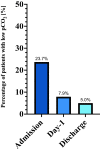Clinical determinants and prognostic significance of hypocapnia in acute heart failure
- PMID: 36207364
- PMCID: PMC9546863
- DOI: 10.1038/s41598-022-20525-9
Clinical determinants and prognostic significance of hypocapnia in acute heart failure
Abstract
The aim of this research was to examine the prevalence of hyperventilation (defined by pCO2 value) among acute heart failure (AHF) patients and to link it with potential triggers and prognosis. All patients underwent dyspnea severity assessment and capillary blood examination on hospital admission and during hospitalization. Out of 241 AHF patients, 57(24%) were assigned to low pCO2 group (pCO2 ≤ 30 mmHg) and 184 (76%) to normal pCO2 group (pCO2 > 30 mmHg). Low pCO2 group had significantly lower HCO3- (22.3 ± 3.4 vs 24.7 ± 2.9 mmol/L, p < 0.0001) and significantly higher lactate level (2.53 ± 1.6 vs 2.14 ± 0.97 mmol/L, p = 0.03). No differences between groups were observed in respect to the following potential triggers of hyperventilation: hypoxia (sO2 92.5 ± 5.2 vs 92 ± 5.6% p = 0.57), infection (CRP 10.5[4.9-26.4]vs 7.15[3.45-17.35] mg/L, p = 0.47), dyspnea severity (7.8 ± 2.3vs 8.0 ± 2.3 points, p = 0.59) and pulmonary congestion (82.5 vs 89.1%, p = 0.19), respectively. Low pCO2 value was related to an increased 4-year all-cause mortality hazard ratio (HR) (95% CI) 2.2 (1.3-3.6); p = 0.002 and risk of death and of rehospitalization for HF, HR (95% CI) 2.0 (1.3-3.0); p = 0.002. Hyperventilation is relatively frequent in AHF and is related to poor prognosis. Low pCO2 was not contingent on expected potential triggers of dyspnea but rather on tissue hypoperfusion.
© 2022. The Author(s).
Conflict of interest statement
The authors declare no competing interests.
Figures



Similar articles
-
Hypocapnia is an independent predictor of in-hospital mortality in acute heart failure.ESC Heart Fail. 2023 Apr;10(2):1385-1400. doi: 10.1002/ehf2.14306. Epub 2023 Feb 6. ESC Heart Fail. 2023. PMID: 36747311 Free PMC article.
-
Prognostic value of decreased peripheral congestion detected by Bioelectrical Impedance Vector Analysis (BIVA) in patients hospitalized for acute heart failure: BIVA prognostic value in acute heart failure.Eur Heart J Acute Cardiovasc Care. 2017 Jun;6(4):339-347. doi: 10.1177/2048872616641281. Epub 2016 Apr 12. Eur Heart J Acute Cardiovasc Care. 2017. PMID: 27073131
-
Spot urine sodium in acute heart failure: differences in prognostic value on admission and discharge.ESC Heart Fail. 2021 Aug;8(4):2597-2602. doi: 10.1002/ehf2.13372. Epub 2021 May 1. ESC Heart Fail. 2021. PMID: 33932273 Free PMC article.
-
Relief and Recurrence of Congestion During and After Hospitalization for Acute Heart Failure: Insights From Diuretic Optimization Strategy Evaluation in Acute Decompensated Heart Failure (DOSE-AHF) and Cardiorenal Rescue Study in Acute Decompensated Heart Failure (CARESS-HF).Circ Heart Fail. 2015 Jul;8(4):741-8. doi: 10.1161/CIRCHEARTFAILURE.114.001957. Epub 2015 Jun 3. Circ Heart Fail. 2015. PMID: 26041600 Free PMC article. Clinical Trial.
-
[Effect of therapeutic hyperventilation on blood lactate concentration].Anaesthesist. 1983 Oct;32(10):469-74. Anaesthesist. 1983. PMID: 6418024 German.
Cited by
-
Hypocapnia and its relationship with in-hospital mortality in acute heart failure patients: Insights from the Indonesian multicenter ICCU registry.Narra J. 2025 Apr;5(1):e1638. doi: 10.52225/narra.v5i1.1638. Epub 2025 Jun 24. Narra J. 2025. PMID: 40352248 Free PMC article.
-
Clinical Review of Hypertensive Acute Heart Failure.Medicina (Kaunas). 2024 Jan 10;60(1):133. doi: 10.3390/medicina60010133. Medicina (Kaunas). 2024. PMID: 38256394 Free PMC article. Review.
-
A Novel Nomogram for Predicting the Risk of Acute Heart Failure in Intensive Care Unit Patients with COPD.Chronic Obstr Pulm Dis. 2025 Mar 27;12(2):117-126. doi: 10.15326/jcopdf.2024.0562. Chronic Obstr Pulm Dis. 2025. PMID: 39912871 Free PMC article.
-
Prognostic significance and clinical determinants of residual dyspnoea at discharge in acute heart failure: a single-centre, prospective observational study.BMJ Open. 2023 Nov 19;13(11):e075302. doi: 10.1136/bmjopen-2023-075302. BMJ Open. 2023. PMID: 37984947 Free PMC article.
-
A Methodological Perspective on the Function and Assessment of Peripheral Chemoreceptors in Heart Failure: A Review of Data from Clinical Trials.Biomolecules. 2022 Nov 26;12(12):1758. doi: 10.3390/biom12121758. Biomolecules. 2022. PMID: 36551186 Free PMC article. Review.
References
-
- Haack KKV, Marcus NJ, del Rio R, Zucker IH, Schultz HD. Simvastatin treatment attenuates increased respiratory variability and apnea/hypopnea index in rats with chronic heart failure. Hypertension (Dallas, Tex.: 1979) 2014;63(5):1041–1049. doi: 10.1161/HYPERTENSIONAHA.113.02535. - DOI - PMC - PubMed
-
- Ponikowski P, Banasiak W. Chemosensitivity in chronic heart failure. Heart Fail. Monit. 2001;1(4):126–131. - PubMed
Publication types
MeSH terms
Substances
LinkOut - more resources
Full Text Sources
Medical
Research Materials
Miscellaneous

